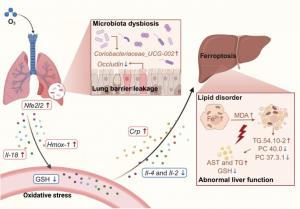Air pollution's double strike: How ozone disrupts the lung–liver connection
GA, UNITED STATES, September 17, 2025 /EINPresswire.com/ -- Ozone, once considered primarily a threat to the lungs, is now shown to affect much more than breathing. Researchers have uncovered that prolonged exposure to environmentally relevant ozone levels not only inflames and weakens the lungs but also disrupts liver health through a chain reaction. By disturbing the lung microbiome and triggering oxidative stress, ozone exposure sets off a cascade of inflammatory signals that compromise the liver's ability to regulate lipids and resist cellular damage. This discovery reveals a hidden "lung–liver axis" of vulnerability, highlighting how an everyday air pollutant can silently undermine multiple organs over time.
Ozone pollution is rising worldwide, frequently exceeding safety thresholds in urban centers and industrial regions. Its health risks are well-documented: breathing ozone can worsen asthma, damage airways, and increase the risk of cardiovascular and neurological disorders. Toxicological studies further suggest that ozone generates reactive oxygen species and breaks down protective lung barriers. At the same time, researchers have observed links between ozone exposure and systemic metabolic problems, such as lipid disorders and oxidative stress. Yet the exact biological connections between respiratory exposure and distant organ damage remain elusive. Because of these challenges, it is essential to investigate how ozone crosses organ boundaries and aggravates systemic injury.
A team from Fudan University and collaborating institutions has revealed how ozone exerts multi-organ effects by disturbing the delicate dialogue between the lungs and liver. Their findings, published June 30, 2025, in Frontiers of Environmental Science & Engineering, show that mice exposed to ozone for 30 days developed not only lung injury but also liver dysfunction driven by microbial imbalance. By identifying the lung–liver axis as a critical pathway, the study provides fresh insight into how a common pollutant can silently compromise human health far beyond the respiratory system.
In controlled experiments, mice were exposed to ozone at concentrations mirroring polluted cities. Lung tissue analyses revealed congestion, inflammation, and weakened antioxidant defenses. Key protective genes such as Sod2 and Ucp2 were suppressed, while inflammatory markers like Il-1β and Il-18 rose sharply. Tight junction proteins including Occludin declined, pointing to compromised barrier integrity.
The lung microbiome also shifted dramatically: diversity dropped, beneficial bacteria dwindled, and harmful taxa associated with inflammation flourished. These microbial disruptions correlated closely with altered immune gene expression, suggesting a direct link between dysbiosis and pulmonary injury.
The damage did not stop there. Despite normal food intake, exposed mice gained less weight and developed liver abnormalities, including necrosis and lipid accumulation. Biochemical tests showed spikes in aspartate aminotransferase (AST), malondialdehyde (MDA), and iron ions, alongside depleted glutathione. Lipidomic profiling confirmed signs of ferroptosis, a type of cell death tied to oxidative imbalance. Mediation analysis revealed that lung injury and microbial changes played a central role in liver lipid dysregulation, firmly establishing the lung–liver axis as the bridge through which ozone spreads its harm.
"Ozone has traditionally been viewed as a respiratory hazard, but our work shows its influence reaches much further," said Dr. Dan Li, corresponding author of the study. "By altering the lung microbiome, ozone triggers a chain of events that culminates in liver injury and metabolic disruption. This hidden lung–liver communication sheds light on how environmental exposures can ripple through the body. Recognizing this pathway is essential for understanding the true scope of ozone's health risks and for designing effective strategies to protect vulnerable populations."
The findings underscore the need to view ozone not just as a cause of coughing or asthma, but as a systemic pollutant capable of undermining multiple organs. By uncovering the role of the lung microbiome in mediating liver damage, the study opens new possibilities for interventions—ranging from microbial therapies and antioxidants to targeted policies that curb ozone emissions. It also provides a scientific rationale for more stringent air quality standards worldwide. Ultimately, protecting public health will require not only reducing ozone levels but also addressing the subtle biological connections through which pollutants exert their harm.
References
DOI
10.1007/s11783-025-2038-z
Original Source URL
https://doi.org/10.1007/s11783-025-2038-z
Funding information
This work was supported by the National Key Research and Development Program of China (Grant Nos. 2023YFC3708203 and 2022YFC3704700), the National Natural Science Foundation of China (Grant Nos. 22376033 and 22122601), the Major Project of Guangzhou National Laboratory (Grant No. GZNL2024A01028).
Lucy Wang
BioDesign Research
email us here
Legal Disclaimer:
EIN Presswire provides this news content "as is" without warranty of any kind. We do not accept any responsibility or liability for the accuracy, content, images, videos, licenses, completeness, legality, or reliability of the information contained in this article. If you have any complaints or copyright issues related to this article, kindly contact the author above.

